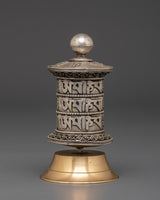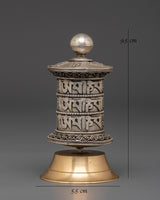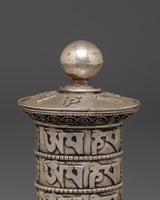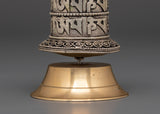



Buddhist Religious Prayer Wheel | Spiritual Healing Wheel for Meditation

100% AUTHENTIC

HANDMADE

FREE SHIPPING
Handcrafted Tibetan Buddhist Prayer Wheel for Daily Mantra Practice and Sacred Rituals
--------------------------------------------------------
Size: 9.5cm (Height) x 5.5cm (Width)
Weight: 0.98kg
Materials: Brass, Silver Coated
--------------------------------------------------------
About our Prayer Wheel:
This Silver-Coated Brass Buddhist Prayer Wheel is a wonderfully constructed sacred object ideal for mindfulness, meditation, and mantra recitation. This little but powerful wheel, measuring 9.5cm in height and 5.5cm in width, is ideal for personal altars, yoga spaces, or as a travel companion for spiritual ceremonies. The exquisite craftsmanship features traditional Tibetan detailing on a brass core coated in shimmering silver, which adds to its visual appeal and spiritual significance.
Weighing 0.98kg, this Tibetan Buddhist prayer wheel has a pleasant weight and balance that reflects its materials and handmade craftsmanship. The exterior cylinder is inscribed with sacred mantras, including the famed "Om Mani Padme Hum," which is said to purify karma and encourage compassion. Spinning the wheel is thought to send these potent wishes into the universe, making it an important tool for Buddhists, spiritual searchers, and sacred art collectors alike.
Introduction to Prayer Wheel
A prayer wheel is cylindrical on a spindle and is used in Tibetan Buddhism. It is typically inscribed with the mantra "Om Mani Padme Hum" and rotated by hand as a form of spiritual practice and to accumulate merit. Spinning the wheel is believed to have the same spiritual benefits as verbally reciting the mantra. The use of prayer wheels is widespread in Tibetan Buddhism and has spread to other cultures.
How does the Buddhist Prayer Wheel benefit us?
The benefits associated with rotating the wheel are numerous. It promotes knowledge, compassion, and bodhicitta in the practitioner and improves siddhis (spiritual powers such as clairvoyance, precognition, etc.). The practitioner can repeat the mantra as often as possible while the wheel is rolling, maintaining a calm, meditative attitude. A Tibetan Buddhist tradition holds that after a practice session, one should dedicate any acquired merits to the benefit of all sentient beings. Then three times Om Ah Hum. This is usually among Tibetans after finishing any Buddhist practice, including the prayer wheel exercise.
How do you set up your own Buddhist Shrine?
• Find a clean, quiet, and uncluttered spot
• Set up an altar table and cover it with an altar cloth that calls to you
• Place your sacred item at the center














